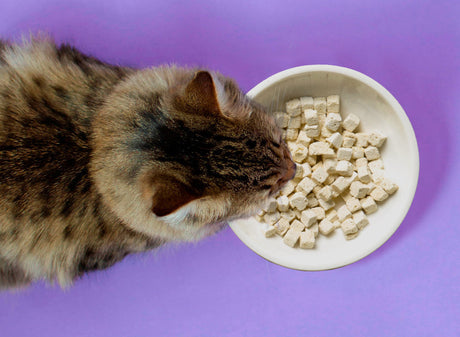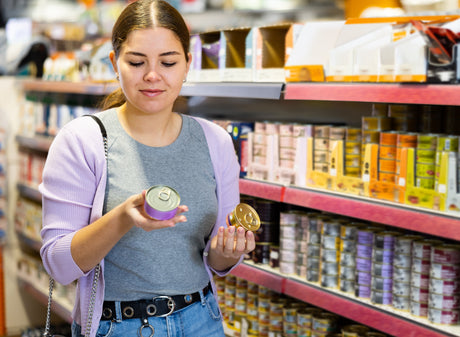Dry Matter Basis (referenced here as DMB) is important to understand when choosing the best pet food for our feline and canine friends. It is a powerful tool for determining the quality of pet food.
That said, as powerful and essential as Dry Matter Basis is, it is rarely discussed with pet owners. Most people have never heard the phrase or had the opportunity to learn what it's all about. Here's what we'll cover as we explore this topic.
- What is Dry Matter Basis?
- Dry Matter Basis Vs As Fed
- Why is Dry Matter Basis Important?
- An Easy Way to Visualize Dry Matter Basis
- How to Calculate Dry Matter Basis
- What Even Are "Fillers" in Pet Food?
- The Importance of High-Quality Ingredients
- And finally - How to Avoid Being Cheated
Sometimes, a visual aid can help clarify information. To enhance your understanding, be sure to check out the video below.
What is Dry Matter Basis?
Simply put, DMB is a way to understand the relative amounts of nutrients (vitamins, minerals, proteins, fats, etc) in pet food. While vital to your pet's health, moisture can complicate measuring certain nutrients. Therefore, we need a way to measure these nutrients as if we removed all the moisture from the food. Dry Matter Basis measures the relative amounts of Dry Matter left over.
Dry Matter Basis allows you to see past fancy marketing, pretty packaging, and vague or unfamiliar ingredients to the actual substance of the food itself.
Dry Matter Basis Vs As Fed
Dry Matter Basis and As Fed refer to two ways of reporting the nutrient content in pet foods, which are essential for accurately comparing nutritional values.
Dry Matter Basis: This method removes the moisture content from the equation, providing nutrient percentages on a dry-weight basis. It allows for a more accurate comparison between different types of pet foods (e.g., wet and dry) because it negates the variable moisture levels, focusing solely on the actual nutrients.
As Fed: This refers to the nutrients in the pet food as it is normally fed, including its moisture content. The "As Fed" figures give you the nutrient values which in this case are lower in concentration compared to the Dry Matter Basis due to the presence of water.

In short, Dry Matter Basis is used for direct nutrient comparison by eliminating moisture content, while As Fed values show nutrient levels as present in the product's current, consumable form.
Ok, But Why is Dry Matter Basis Important?
Understanding the nutrient composition of pet food is crucial for ensuring that our furry friends receive a balanced and nutritious diet. Using DMB, pet owners and veterinarians can make informed decisions about which foods best suit a pet's specific dietary needs. This method allows us to compare pet food products and determine which ones offer our pets the most optimal nutrient profile.
DMB is how one evaluates nutrient levels, moisture content, and guaranteed analysis in pet food to ensure you are providing your pets with the highest-quality nutrition possible. This becomes particularly important when dealing with pets with specific health issues, as their dietary requirements may differ from those of a healthy animal.
For example, if you're shopping for low phosphorus pet food, you know that the DMB can help you distinguish between high-quality food and one that makes many claims but doesn't live up to them.
An Easy Way to Visualize Dry Matter Basis
Let's start with three marbles. They are different colors but all the same size. Each marble represents a nutrient: red = Phosphorus, white = Sodium, and orange = Vitamin C. Now, let's place these marbles into a bowl. Looking into the bowl, we see one marble for each nutrient.
Since all the marbles are the same size and weight, we know the nutrients are present in equal amounts. What does that mean for DMB? Exactly what you think it does. Phosphorus, Sodium, and Vitamin C all have a DMB Measurement of ⅓ (33%).
Unfortunately, as with most measurements (especially those involving %' s), DMB measurements must be put into context. Otherwise, the measurements meant to help you may instead confuse you.
Fortunately, putting them into context is intuitive and easy. And, if all else fails, you can use a Dry Matter Basis Calculator such as this one from catfoodnerds.com. Now, let's keep using our marbles to help visualize DMB within a can of pet food.
The Dry Matter Basis Calculation
The correct context for high-quality foods is the combination of high moisture, high protein, and low phosphorus. The only way to guarantee quality is to have all three together—not just one or two.
Imagine sitting in front of a bowl of water representing a can of cat or dog food. Drop a single red marble - again representing a unit of phosphorus - into the bowl. At this point, the percentage of phosphorus on a dry matter basis is 100%. Why? Even though there is a lot of water, phosphorus is the only dry matter present. Since all the dry matter is phosphorus, the dry matter basis of phosphorus is 100%.
Now, let's add more red marbles, each representing another unit of phosphorus. The percentage of phosphorus on a dry matter basis remains 100%. Why? Because of all the dry matter in the bowl, 100% of it is still phosphorus.
We can add a filler to reduce the phosphorus percentage. Let's use a blue marble to represent this filler. (in the video above, I use blue marbles to represent Powdered Cellulose, a common filler in the pet food industry.) However, the blue marbles can represent any 'filler' commonly used in pet foods.
We add equal amounts of blue marbles (filler) to the red marbles (Phosphorus). The blue marbles are the same size and weight as the red marbles. Therefore, the bowl has an equal amount of phosphorus and filler.

What is the Dry Matter Basis of Phosphorus? 50% because half of the dry matter in the bowl is phosphorus, and the other half is not.
We can further lower the percentage by continuing to add filler. Let's add the same quantity of blue marbles again. Now, the percentage of phosphorus on a dry matter basis is 33%. Of all the dry matter in the bowl, one-third is phosphorus.
As you can see, when fillers are added the percentage of phosphorus dropped, but the actual amount of phosphorus remained the same. Worse still, adding fillers resulted in moisture loss, and our pets, especially cats, rely heavily on moisture in their diet to thrive.
What Are "Fillers" Anyway?
Fillers in pet food can broadly be categorized into two groups: those with minimal nutritional value and those that, although considered "food items," do not serve (primarily) as significant sources of nutrients.
Take powdered cellulose, for instance, which falls into the first category. While powdered cellulose provides negligible amounts of essential vitamins and minerals, its primary purpose is to fill space in pet food.
The second type of filler can be more difficult to spot. It may look like a "normal" food ingredient, like corn. Corn, while not considered a high-value ingredient, does contain some nutritional value. However, it is likely used as a filler if it is used in large amounts, far more than an ideal diet would call for.
How can you determine the amount of any ingredient? While a pet food label won't give exact amounts, it will provide relative amounts. The higher an ingredient is in the list of ingredients, the more it is being used.
Here are two examples of primary ingredients in some popular brand's "Kidney" formula for Cats:

Do these ingredients (or the amount of those ingredients) look like they should be fed to an obligate carnivore like your cat? How about a cat with a potential kidney issue? Furthermore, those are just the names of the ingredients; we still need to discuss their quality, which is of paramount importance here as well. When selecting food for your pet, ingredient quality should also be at the forefront of your mind.
The Importance of Quality Ingredients
So now you've learned that you want to ensure your pet's diet isn't full of fillers and unwanted junk. The other key point when learning about DMB is that fillers aren't necessary when you use high-quality ingredients.
Here is an example relevant to our discussion of phosphorus. The word "Chicken" on an ingredient panel has a precise definition. According to AAFCO, "Chicken" is the dry rendered product from a combination of clean chicken flesh and skin with or without accompanying bone, derived from the whole carcass of chicken, exclusive of feathers, heads, feet, and entrails.
However, there is no confidence-inspiring grading system for that. For most pet foods, the label does not tell you how much skin and bone is in the food, which, combined with added fillers, can lead to nutritional deficiencies.
How to Avoid Being Cheated
Beyond the fact that you may be spending your hard-earned money on skin and bone rather than meat, there are also significant nutritional concerns. Bone contains large amounts of phosphorus (along with calcium and magnesium).
If a company uses meat containing bone (as almost every pet food company does—whether it is a prescription diet or not), it must use fillers to bring the dry matter of phosphorus down to a certain level, according to AAFCO. A few companies, like Weruva, only use boneless and skinless meats to avoid using fillers and naturally keep phosphorus levels low.
Thus, it is vital to prioritize high-quality and high-moisture protein sources, particularly for pets with concerns about kidney health and other severe health conditions. This careful consideration ensures that our feline and canine companions receive nutrition that promotes their overall well-being and supports their specific health needs.
Knowledge is Power!
High-quality ingredients like boneless and skinless meats will immediately set a pet food company apart. Remember, the lower the bone content, the more room for moisture!
Your furry companions deserve the best, so take the time to evaluate and select food that meets their specific dietary needs. Stay informed, ask questions, and prioritize your pet's health and well-being.
Contact pet food companies and ask them about their Dry Matter Basis measurements. A transparent company will gladly provide more details about their measurements and ingredients. Additionally, always consult with your veterinarian to determine the appropriate amount of phosphorus for your cat's or dog's needs before making any dietary changes.
Curious about what Weruva has to offer? Browse our selection of premium pet food products today, and rest assured that by feeding Weruva you are giving your pet everything they need to live an "Awesome Happy Awesome Healthy" life!





